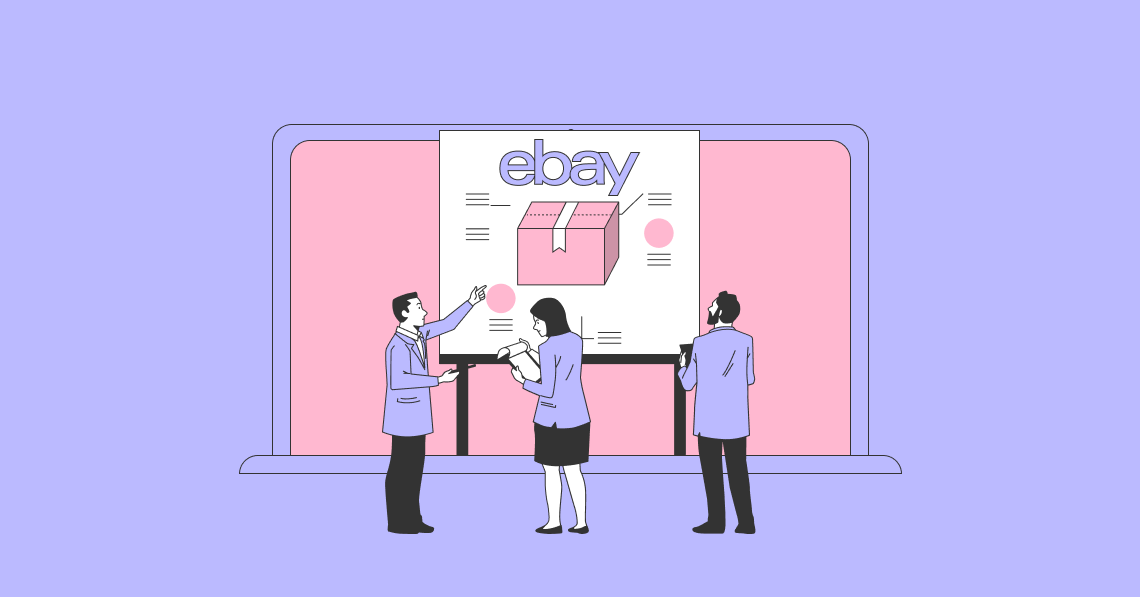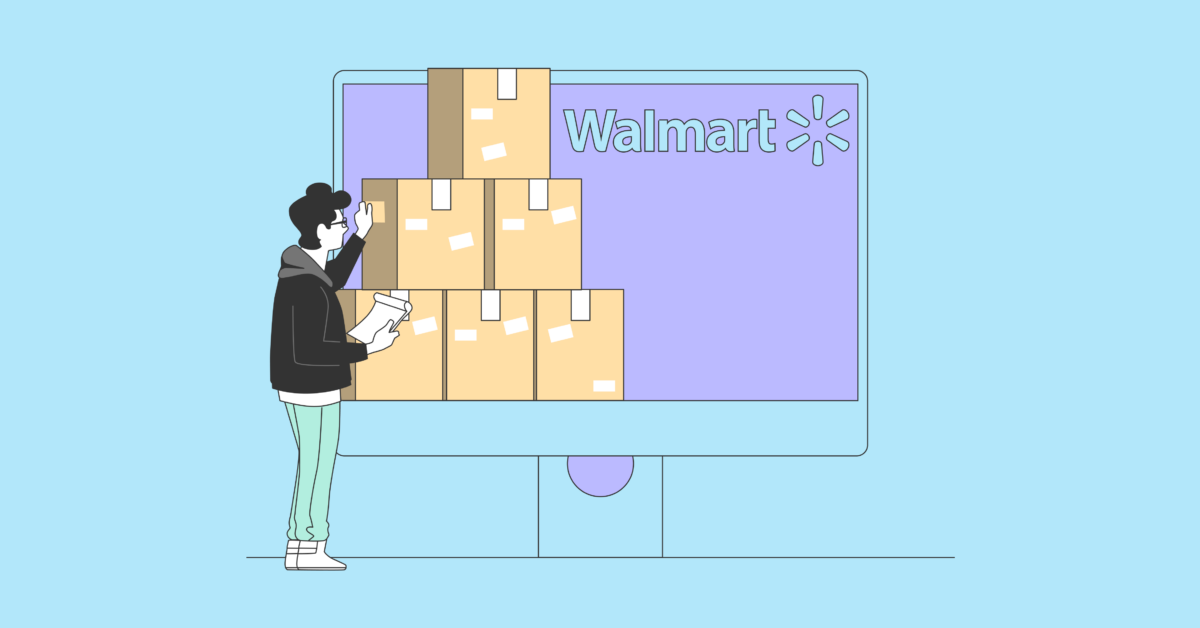As more and more products are being sold online, retailers are farther and farther away from where the products they sell are warehoused. This makes it important to the survival of your business to have an inventory management system that works to keep your products organized and your stock at the right levels to ensure that you can fulfill orders with ease. In this article, we'll walk you through everything you need to know about inventory management—what it is, key inventory management terms you should know, common benefits and challenges, inventory management techniques, and inventory management tools you can use to streamline the process.
What Is Inventory Management and Why It's a Big Deal for Your eCommerce Business:
What Is Inventory Management?
Inventory management is the process of sourcing, storing, and selling products. It involves staying on top of things like how much of a product you have, at what price you should be selling it, where to store it, and how long to hang onto it. Inventory management is important no matter what size your business as it can save you time and money, as well as prevent product spoilage and waste.
Inventory Management Glossary
- Carrying Cost: yearly costs associated with holding unsold inventory.
- Centralized Inventory Control Software: software that lets you track inventory numbers when selling through multiple channels (Amazon, eBay, Shopify, etc).
- Dead Stock: inventory that didn't sell during the forecasted period.
- FIFO (First In, First Out) Accounting: inventory, materials, or components acquired first are sold first.
- Inventory Audit: manually checking your stock to ensure it matches up with what your tracking system says.
- Inventory Control: strategy of warehousing and fulfilling products after they've already been sourced.
- Just-In-Time (JIT) Fulfillment: a fulfillment method in which inventory is created, produced, and assembled just in time to keep up with consumer demand.
- Minimum Viable Stock: the minimum number of products and variants you need to keep up with demand and order fulfillment.
- SKU: "stock keeping unit;" distinct product types you have for sale.
- Stockout: when you run out of a specific product that consumers want to purchase.
Benefits of Inventory Management
Inventory management is important if you want to make sure that you have enough products available to meet the demand of your customers. When inventory isn't tracked and handled properly, your eCommerce business could lose money or sales that can't be filled or lose money because you carry too much of a product that isn't moving. Here are some of the key ways inventory management can help your business.
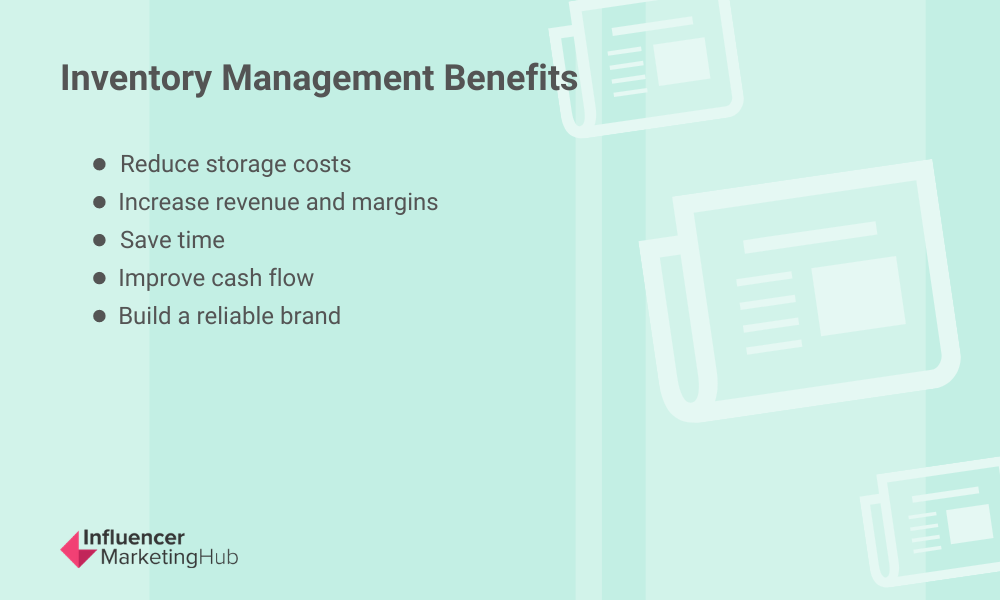
Reduce Storage Costs
Warehousing costs tend to fluctuate depending on how much you have to store. In an ideal situation, you would only ever have enough inventory to cover what you expect to sell over a specific period of time. This means that you won't be scrambling to source enough product to meet demand nor will you have dead stock taking up space and increasing your storage costs.
Increase Revenue & Margins
When you can forecast the right amount of inventory, you'll be able to avoid stockouts and dead stock. You'll also be able to negotiate better deals with wholesalers and suppliers because you know how much you need. This improves your business's revenue and profit margins.
Save Time
Most inventory management systems these days are software-based. This means that you'll be able to save time on inventory management tasks.
Improve Cash Flow
Inventory management also helps eCommerce businesses improve cash flow. Chances are, your inventory has already been paid for once it hits your warehouse, so you're out money unless you can sell it. Both how much you can sell and how much you've purchased have a direct impact on your cash flow. When you have an inventory management system in place, you'll have a much better idea of how much product you should purchase to meet need so you can make sales and fulfill orders efficiently, bringing in the cash flow you need to keep your business running.
Build a Reliable Brand
One of the often overlooked benefits of inventory management is that it can help you become a more reliable brand. When you have the right amount of inventory on hand, you can fulfill orders faster. This builds trust with your customers and can help you turn a one-off customer into a repeat customer.
Common Challenges of Inventory Management
As with most things, inventory management does have its share of challenges. It's important to know about and understand these challenges so you can watch out for them and limit the possibility of these challenges interfering with your business.
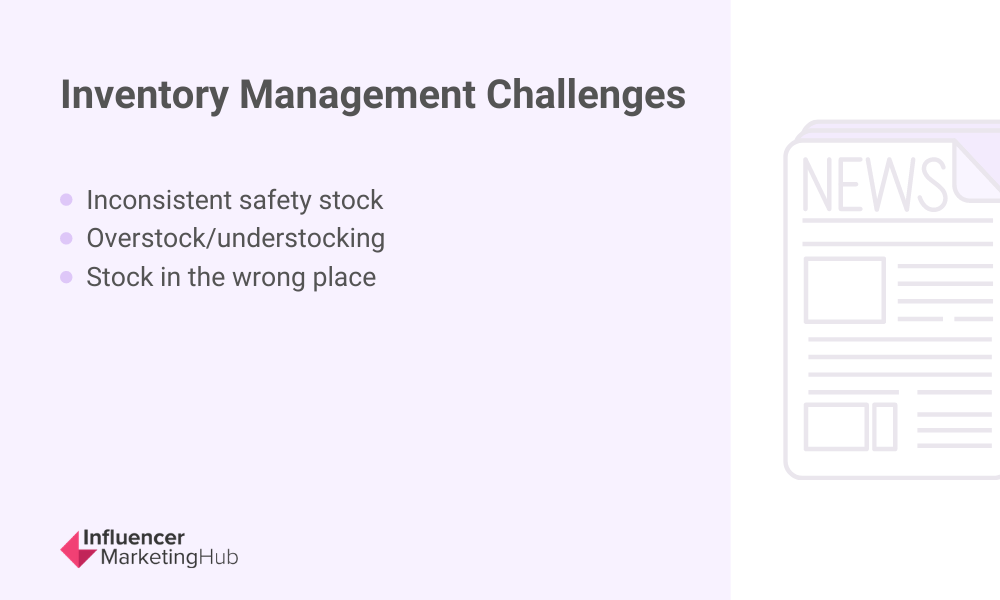
Inconsistent Safety Stock
Safety stock is stock that can help you continue to deliver customer orders efficiently even if there's a spike in demand. Think for a moment about what happened with toilet paper and hand sanitizer during the early stages of the COVID-19 pandemic in 2020 and you'll understand the importance of safety stock. Without it, the situation could have been even worse.
Overstocking & Understocking
Another common inventory management challenge is keeping the right stock level and not overstocking or understocking. You want to get the balance right so you have enough product to meet customer demand without leaving you with tons of stock on hand. Your inventory management system will help you understand the natural ebbs and flows of the market for your particular products so you can adapt inventory to meet them.
Stock in the Wrong Place
Our world is becoming increasingly decentralized and that means that your eCommerce business is likely to use different warehouses around the world. Make sure that you have the right amount of stock in the right warehouses so you're not causing a kink in your order fulfillment process.
7 Common Inventory Management Techniques
Now that you have a better understanding of inventory management, its benefits, and the challenges you can face, let's talk about some of the more common inventory management techniques we've seen. This is by no means an exhaustive list, but these are the inventory management techniques we've heard about most often from eCommerce business owners.
1. Just-in-Time Inventory Management
We defined Just-in-Time inventory management earlier. It's a great way to control inventory costs because you're only bringing in inventory on an as-needed basis. There's minimal risk of dead stock with this technique.
2. FIFO/LIFO
FIFO has a counterpart called LIFO, or Last In, First Out. While FIFO helps keep inventory fresh, LIFO prevents inventory from spoiling since the newer inventory is sold first.
3. ABC Analysis
This is an inventory categorization technique that breaks products into groups based on impact on overall inventory costs. Category A are your most valuable products. Category B are the products that fall between most and least valuable. Category C products are those products that feed smaller transactions and are viewed as less important individually though collectively they probably make up the largest portion of products sold.
4. Dropshipping
Many entrepreneurs treat dropshipping as a business venture. With dropshipping, you don't keep any of the products that you sell in stock. Instead, customers buy the product from you and you purchase the item from a third party. The third party then ships it to the customer. You never see the product yourself. Intrigued? Here's how to start a dropshipping business.
5. Economic Order Quantity
EOQ is a formula for the ideal order quantity your company needs and takes into consideration variables like demand rate, product costs, and more. The goal of this inventory management technique is to minimize related costs and free up cash you have tied up in inventory.
6. Minimum Order Quantity
MOQ is a supplier-side term that refers to the smallest amount of stock a supplier will sell to a retailer. Products that cost more to produce are likely to have a smaller MOQ.
7. Reorder Point
Reorder point (ROP) inventory management means that you have a minimum quantity you hit before placing another order with a supplier. This number is typically going to be higher than your safety stock number to account for lead time. ROP can be helpful in avoiding stockouts and holding costs.
Do You Need an Inventory Management Tool?
As we've walked through the inventory management techniques above, you've probably realized that there's a lot to think about when it comes to inventory management for your eCommerce business. And you're right! That's why we recommend even smaller eCommerce businesses invest in an inventory management tool to help track stock, automate certain business aspects (purchase orders, anyone?), compile year-end inventory reports, and more.
There are quite a few inventory management software tools on the market, so let's take a look at a few of our favorites.
QuickBooks Commerce
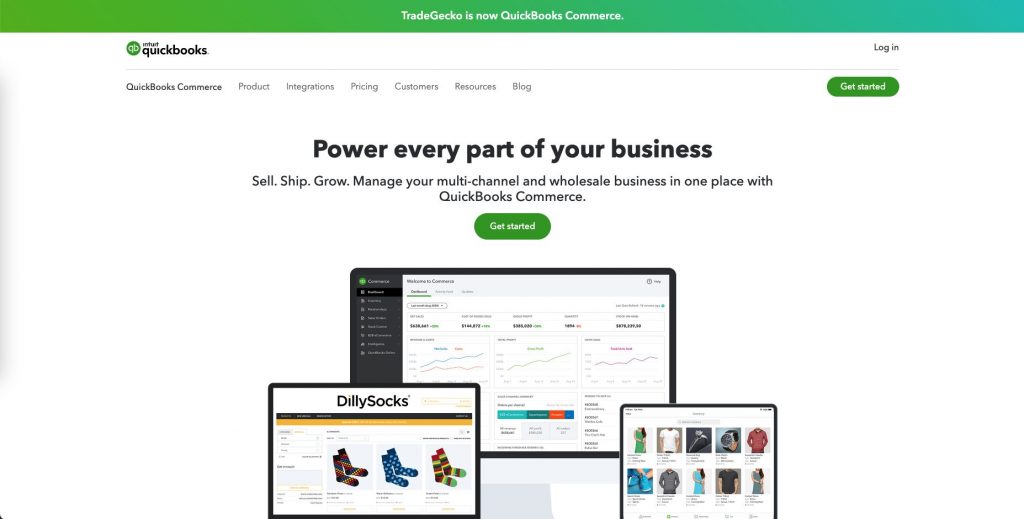
QuickBooks Commerce lets brands manage both retail and wholesale operations. You can use the system and app extensions to automate workflows, manage multiple sales channels, expedite payments, manage multiple fulfillment locations, and a lot more.
Pros and Cons of QuickBooks Commerce
- 😊 Supports multiple sales channels
- 😊 Easy to use
- 😊 Great for supply chain professionals
- 😩 Software can be buggy
- 😩 Customer support leaves a bit to be desired
💰 Pricing
QuickBooks Commerce offers four pricing plans:
- Founder: $39/month
- Lite: $79/month when billed annually; $99/month when billed monthly
- Small Business: $199/month when billed annually; $249/month when billed monthly
- Business: $599/month when billed annually; monthly subscription not available
QuickBooks Inventory Management
![]()
QuickBooks Online is one of the most popular accounting software in the world. And it just so happens to include inventory management that seamlessly integrates with the rest of your accounting needs. With QuickBooks, you can track stock levels, invoicing, and bills of materials, as well as get real-time inventory valuations and track purchase orders—all from a single tool.
Pros and Cons of QuickBooks Inventory Management
- 😊 Easy to use
- 😊 Flexible
- 😊 Third-party integrations
- 😊 Time tracking and tax support
- 😩 Lacks industry-specific features
- 😩 Limited analytics outside of accounting functions
💰 Pricing
QuickBooks Online offers two pricing plans that include inventory management:
- Plus: $35/month (increases to $70/month after three months)
- Advanced: $75/month (increases to $150/month after three months)
NetSuite
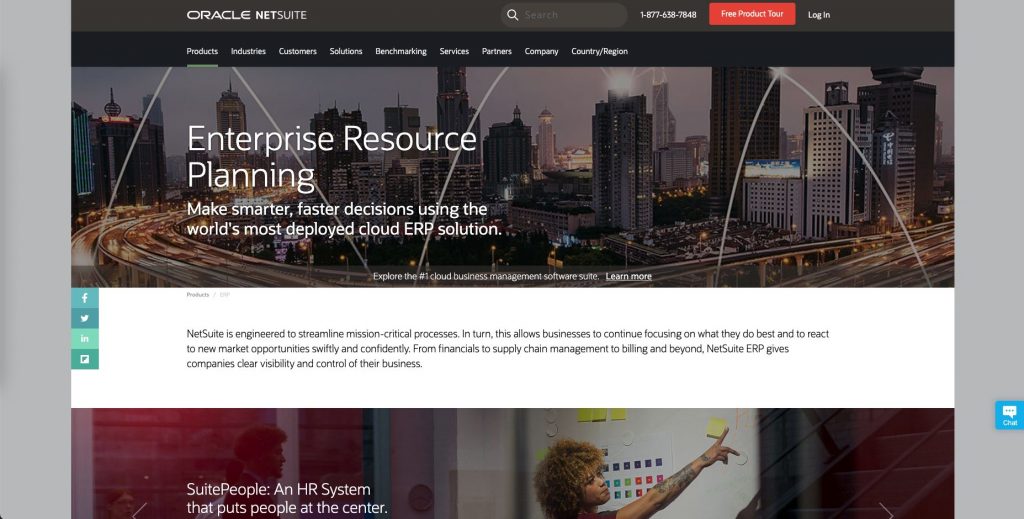
NetSuite is an all-in-one business solution that's best for large and enterprise businesses. It includes everything you need for accounting, marketing, and inventory management. It's cloud-based and brings together financial processes and back-office functions into a single platform.
Pros and Cons of NetSuite ERP
- 😊 Tons of integrations
- 😊 Scalable
- 😊 Customizable forms and reports
- 😊 Supports multiple currencies
- 😩 Steep learning curve
- 😩 Expensive option for small to mid-size businesses
💰 Pricing
NetSuite’s price is customized to the needs of each customer and final pricing is determined based on certain things like ERP configuration, add-on modules, total user count, and contract length. The base license is $999/month plus $99/user/month.
Zoho Inventory Management
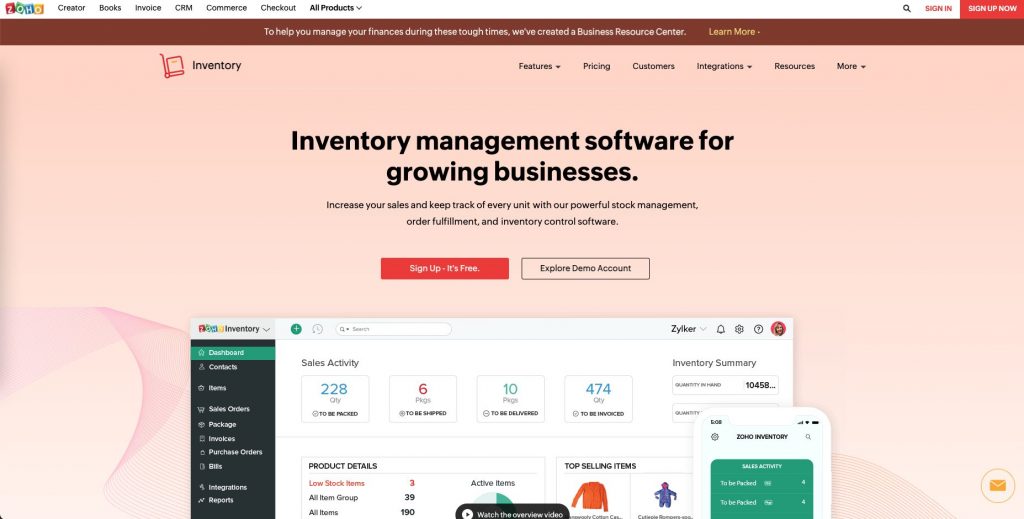
Zoho is one of the best-known tools on the market and it just so happens to offer an inventory management module. With Zoho Inventory Management, you can manage both online and offline orders, link to Amazon, Shopify, and eBay accounts, manage drop shipments, create purchase orders, and more. It also has an end-to-end tracking system for every single item in your inventory and multiple shipping integrations to choose from.
Pros and Cons of Zoho Inventory Management
- 😊 Integrations with other tools
- 😊 Integrates with a dedicated CRM
- 😊 Easy to use
- 😩 Tutorials aren't super helpful
💰 Pricing
Zoho Inventory Management offers a limited free plan and four pricing plans:
- Standard: $59/month when billed annually; $79/month when billed monthly
- Professional: $99/month when billed annually; $129/month when billed monthly
- Premium: $159/month when billed annually; $199/month when billed monthly
- Elite: $239/month when billed annually; $299/month when billed monthly
Fishbowl Inventory
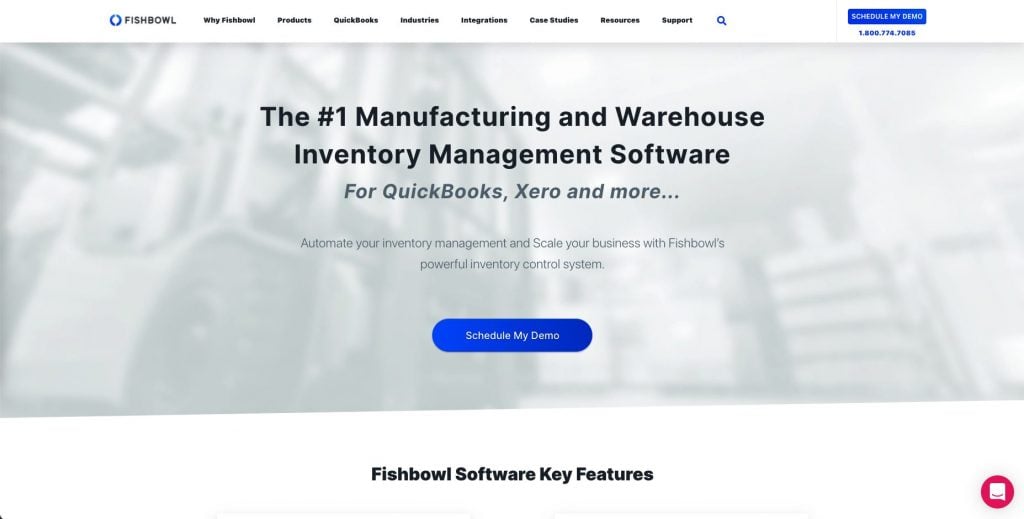
Fishbowl Inventory doesn't seem to be as well-known as QuickBooks or Zoho, but it's shown up on its fair share of these best inventory management system lists. And for good reason. With Fishbowl, you can track dropshipping, assess business needs, gather inventory data, utilize a barcoding system, and more. It integrates with Salesforce CRM, ShipStation, and your accounting software to provide the data you need to keep your business running smoothly.
Pros and Cons of Fishbowl Inventory
- 😊 Integrations with other tools
- 😊 Great for reporting and tracking
- 😊 Real-time inventory updates
- 😩 A bit pricing to start
- 😩 Only available in English
💰 Pricing
Fishbowl Inventory starts at $4,395. All user licenses are concurrent and non-expiring.
Boost Your Bottom Line With Inventory Management
For many eCommerce businesses, inventory is the largest asset the business has. And that means you need to take steps to ensure that you're handling it accurately. We recommend choosing one of the inventory management systems we've covered here to help you track and manage your inventory effectively.
Frequently Asked Questions
What is warehouse management?
Similar to inventory management tracking inventory, warehouse management tracks what's happening across warehouses. This means you can control inventory and other warehouse operations like supply chain management, fulfillment, receiving, distribution, and more.
What is 3PL?
3PL is an acronym for "third-party logistics." This is the inventory and supply chain management practice of outsourcing to third parties. Essentially meaning that warehouse management, shipping, and other aspects of logistics would be handled by different third parties on your behalf. It's generally lower cost upfront, but more expensive over time to use 3PL instead of building your own supply chain.
How do I get started with inventory management?
When you're ready to get started with inventory management, the best and most important thing you can do is assess where you currently are. What challenges and barriers are you facing when it comes to inventory management (stockouts, deadstock, etc). From there, find out if a tool you're currently using has an inventory management module you can add.
What KPIs should I be tracking?
There are a few important performance indicators for inventory management, such as:
- Average inventory: the average amount of inventory you have on-hand at any point in time
- Holding costs: the value of the amount of inventory you have on-hand at any point in time
- Inventory turnover ratio: the amount of time it takes to sell out of an inventory order

